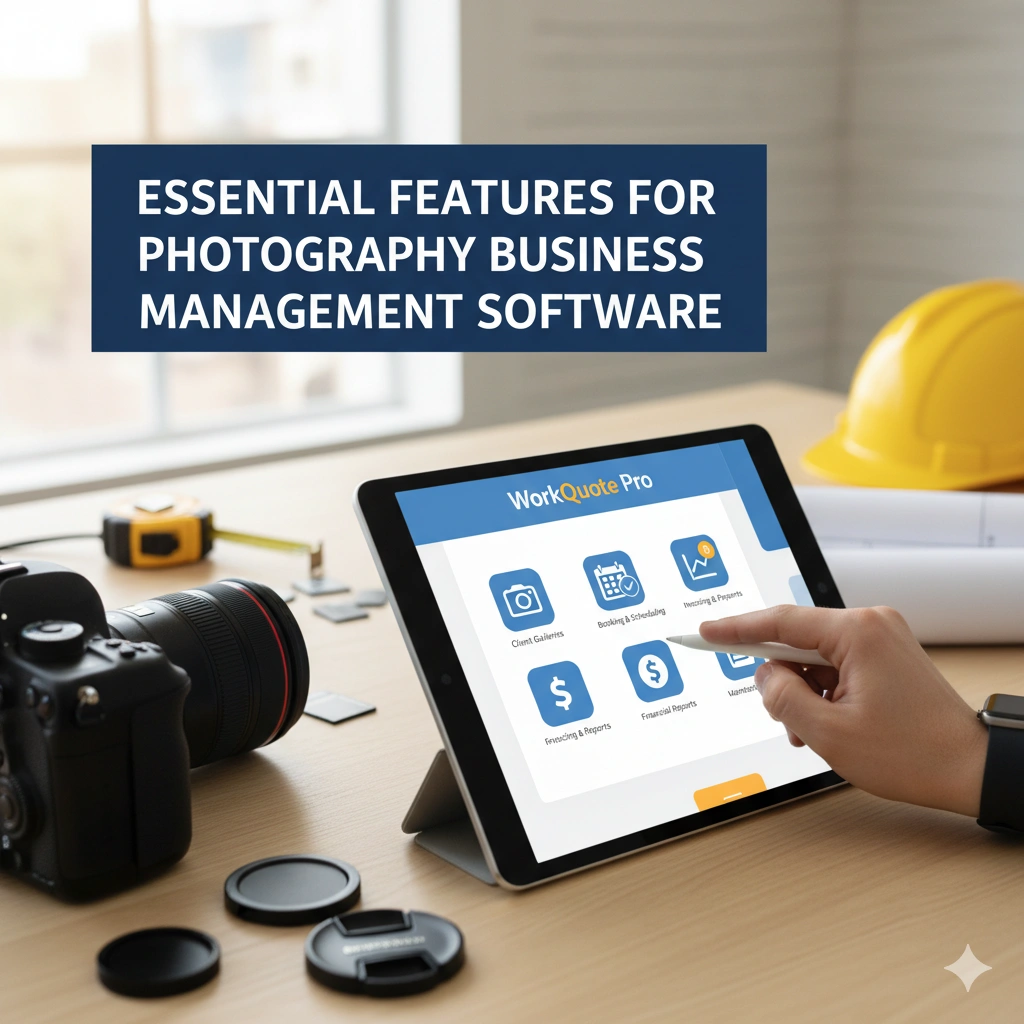
Learn proven strategies to craft compelling service estimates that convert prospects into paying clients. Master the art of professional estimate creation to boost your win rate and grow your service business.
Creating professional service estimates is one of the most critical skills for winning new business. Whether you're a freelancer, contractor, or service provider, your estimate often serves as the first formal impression potential clients have of your professionalism and capabilities. A well-crafted estimate can be the difference between landing a lucrative contract and watching it go to a competitor.
The challenge many service professionals face is creating estimates that strike the perfect balance between competitive pricing, comprehensive scope definition, and professional presentation. Too often, estimates are hastily thrown together, lacking the detail and polish that instills confidence in potential clients. This comprehensive guide will transform your approach to estimate creation, helping you win more jobs while maintaining profitable margins.
Understanding the Psychology of Client Decision-Making
Before diving into the technical aspects of estimate creation, it's essential to understand how clients evaluate service proposals. Most clients aren't simply looking for the lowest price – they're seeking value, reliability, and confidence that their project will be completed successfully.
Clients typically evaluate estimates based on several key factors: clarity of scope, professionalism of presentation, perceived expertise, timeline feasibility, and overall value proposition. Your estimate needs to address each of these concerns while positioning your business as the obvious choice.
Research shows that clients often make decisions within the first few seconds of reviewing an estimate. This means your document's visual appeal and initial impression are just as important as the numbers inside. A professional-looking estimate immediately communicates competence and attention to detail – qualities clients want in their service providers.
Essential Components of Winning Service Estimates
Every professional service estimate should include specific components that work together to create a compelling proposal. These elements serve both practical and psychological purposes, addressing client concerns while showcasing your professionalism.
Professional Header and Branding
Your estimate should begin with a clean, professional header that includes your business name, logo, contact information, and relevant licensing or certification numbers. This immediately establishes credibility and makes it easy for clients to reach you with questions or acceptance.
Include the estimate date, expiration date, and a unique estimate number for tracking purposes. These details demonstrate organization and create urgency for client decision-making. A typical expiration period of 30 days encourages prompt responses while allowing reasonable consideration time.
Client Information and Project Details
Clearly identify the client and project location, including any specific details gathered during your initial consultation. This section should demonstrate that you understand their unique requirements and have tailored your proposal accordingly.
Reference any previous conversations, site visits, or specific client requests. This personalization shows attention to detail and helps clients feel confident that you understand their needs. It also serves as documentation of what was discussed and agreed upon.
Detailed Scope of Work
The scope of work section is arguably the most critical component of your estimate. This is where you demonstrate expertise while setting clear expectations for what will and won't be included in your service.
Break down your services into logical categories or phases, using clear, jargon-free language that clients can easily understand. Be specific about materials, methods, timelines, and deliverables. The more detailed your scope, the fewer surprises and disputes you'll encounter later.
Include both what is included and what is specifically excluded from your proposal. This prevents scope creep and protects you from clients who might assume additional services are included in your quoted price.
Pricing Strategies That Win Jobs
Pricing is often the most challenging aspect of estimate creation. Price too high, and you lose the job to competitors. Price too low, and you either work for minimal profit or raise suspicions about quality. The key is presenting your pricing in a way that emphasizes value while remaining competitive.
Transparent Pricing Structure
Avoid presenting a single lump sum without explanation. Instead, break down your pricing into logical components that help clients understand where their money is going. This might include labor, materials, equipment, permits, and any subcontractor costs.
Itemized pricing serves multiple purposes: it demonstrates transparency, helps justify your total cost, makes it easier to adjust scope if needed, and shows clients exactly what they're paying for. This approach builds trust and reduces price objections.
Value-Based Pricing Presentation
Rather than simply listing costs, frame your pricing in terms of value delivered. Highlight the benefits clients will receive, the problems you'll solve, and the expertise you bring to their project. This shifts the conversation from pure cost comparison to value evaluation.
Consider including brief explanations of why certain services or materials are necessary. For example, if you're using premium materials, explain how they'll save the client money in the long term through durability or energy efficiency.
Professional Presentation and Formatting
The visual presentation of your estimate significantly impacts client perception. A well-formatted, professional-looking document suggests that you'll bring the same attention to detail to their project.
Use consistent fonts, spacing, and formatting throughout your document. Avoid cluttered layouts or overwhelming amounts of text. White space is your friend – it makes documents easier to read and appears more professional.
Consider using modern estimate software or templates that automatically format your information professionally. Tools like Adobe Acrobat can help create polished PDF estimates that maintain formatting across different devices and platforms.
Building Trust Through Credibility Indicators
Your estimate should include elements that build confidence in your ability to deliver quality work. These credibility indicators help differentiate you from less established competitors and justify premium pricing.
Credentials and Experience
Include relevant licenses, certifications, insurance information, and years of experience in your field. If you have specialized training or manufacturer certifications, highlight these qualifications prominently.
Consider adding a brief company overview or bio that showcases your expertise and track record. Client testimonials or references to similar projects can also strengthen your credibility.
Professional Policies and Guarantees
Clearly state your payment terms, warranty information, and any satisfaction guarantees you offer. These policies demonstrate professionalism and give clients confidence in your commitment to quality work.
Include information about your insurance coverage, bonding status, and any industry associations you belong to. These details reassure clients that you're a legitimate, established business.
Effective Communication and Follow-Up
Creating a great estimate is only half the battle – you also need to present it effectively and follow up appropriately. How you deliver and discuss your estimate can significantly impact your win rate.
Presentation Method
Whenever possible, present your estimate in person or via video call rather than simply emailing it. This allows you to explain your proposal, answer questions immediately, and gauge client reactions in real-time.
During your presentation, walk through each section of your estimate, emphasizing the value you'll provide and addressing any concerns that arise. This personal touch often makes the difference between winning and losing a job.
Strategic Follow-Up
Develop a systematic follow-up process that keeps you top-of-mind without being pushy. A good approach might include an initial follow-up within 48 hours, a check-in at the one-week mark, and a final follow-up before your estimate expires.
Use follow-up opportunities to provide additional value, such as sharing relevant articles, answering new questions, or offering to adjust your proposal based on changing requirements.
Common Mistakes That Cost Jobs
Understanding what not to do is just as important as knowing best practices. Many service professionals unknowingly sabotage their chances with common estimate mistakes.
Vague or Incomplete Scope
One of the biggest mistakes is providing estimates with vague or incomplete scope descriptions. Clients need to understand exactly what they're getting for their money. Ambiguous language creates uncertainty and makes it difficult for clients to compare proposals fairly.
Always be specific about deliverables, timelines, and methods. If something is unclear, it's better to ask clarifying questions than to make assumptions that could lead to problems later.
Poor Presentation Quality
Estimates filled with typos, inconsistent formatting, or unprofessional appearance immediately undermine credibility. These presentation issues suggest carelessness that clients worry might extend to your actual work quality.
Always proofread your estimates carefully and consider having someone else review them before submission. Professional presentation is a simple way to stand out from competitors who don't pay attention to these details.
Leveraging Technology for Better Estimates
Modern technology offers numerous tools to streamline estimate creation while improving quality and professionalism. The right software can save time, reduce errors, and create more compelling proposals.
Professional estimating software typically includes features like customizable templates, automated calculations, digital signatures, and client communication tools. These features not only improve efficiency but also enhance the client experience.
Cloud-based solutions allow you to access your estimates from anywhere and make real-time updates during client meetings. Integration with other business tools like scheduling and invoicing software can further streamline your workflow.
Consider platforms like Salesforce CPQ for complex service businesses or simpler solutions for straightforward service estimates. The key is choosing tools that match your business complexity and budget.
Industry-Specific Considerations
Different service industries have unique requirements and client expectations that should be reflected in your estimates. Understanding these nuances can give you a competitive advantage in your specific market.
Home Services and Contracting
For home services like HVAC, plumbing, or landscaping, clients often prioritize reliability and warranty coverage. Your estimates should emphasize your licensing, insurance, and guarantee policies. Include photos or diagrams when helpful for explaining complex work.
Timeline information is particularly important for home services, as clients need to plan around disruptions to their daily routines. Be realistic about scheduling and communicate any factors that might affect timing.
Professional Services and Consulting
Professional service estimates should emphasize expertise, methodology, and expected outcomes. Clients want to understand not just what you'll do, but how you'll approach their challenges and what results they can expect.
Consider including case studies or examples of similar work you've completed successfully. This helps clients visualize the value you'll provide and builds confidence in your ability to deliver results.
Measuring and Improving Your Win Rate
Continuously improving your estimate process requires tracking key metrics and gathering feedback from both won and lost opportunities. This data-driven approach helps identify areas for improvement and optimize your success rate.
Track metrics like estimate-to-job conversion rate, average time from estimate to decision, and common objections or questions from clients. This information reveals patterns that can guide improvements to your process.
When you lose a job, try to understand why. Was it price, timing, scope, or presentation issues? This feedback is invaluable for refining your approach and winning more jobs in the future.
Consider conducting brief surveys with clients who accept your estimates to understand what factors influenced their decision. This positive feedback can help you emphasize the right elements in future proposals.
Regular review and refinement of your estimate process will lead to consistently better results. Small improvements in presentation, pricing strategy, or follow-up can significantly impact your overall win rate and business growth.
Professional service estimates are powerful business tools that can dramatically impact your success rate and profitability. By focusing on clear communication, professional presentation, and value-based positioning, you'll create estimates that not only win more jobs but also attract the right clients who value quality work. Remember that great estimates are investments in your business growth – the time spent perfecting your process will pay dividends through increased win rates and higher-quality client relationships.

